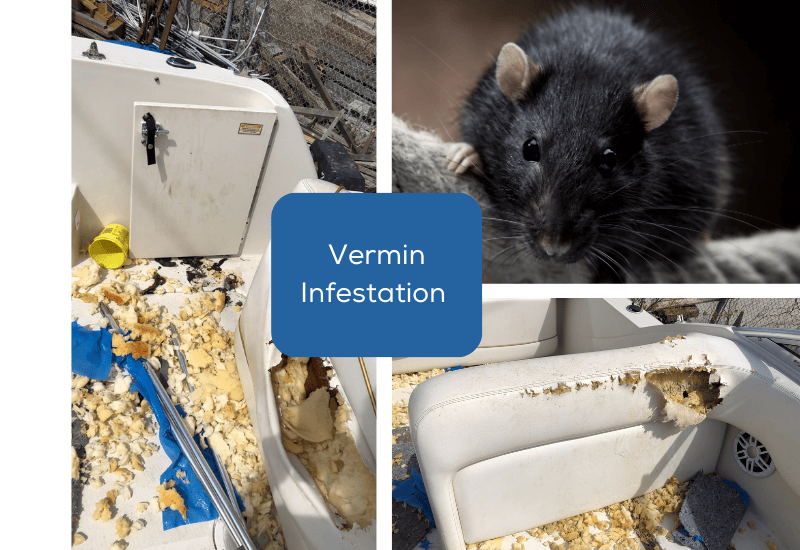Rodents may have a place in some Canadians’ hearts—whether as pets or as the lovable Remy from Ratatouille but when it comes to boats, they’re nothing but trouble. A rodent infestation on your vessel can quickly turn into a nightmare, especially if the boat is left unattended. Mice and rats can gnaw through wiring, upholstery, and even structural components, while their rapid reproduction and droppings create serious sanitation and health hazards. The damage can be extensive, leading to costly repairs and potential insurance claims. To protect your boat, it’s crucial to understand the types of rodents or vermin that pose a threat and implement effective prevention strategies to avoid a rat infestation.
Why are rats the top villain for boat damage?
Rodents must chew to wear down their teeth, targeting wiring, fuel lines, foam, fabric, wood, nets, and cargo. Some rats can chew through, metal concrete and wood. Chewing wires can spark fires, while their urine, feces (40 droppings/day), and contamination spread disease, foul food storage, and introduce fleas and mites in crew quarters. Rats also have a short gestation period of 21 -23 days, and they can breed every 4-5 days unless pregnant and have litters of 6-12 pups. It doesn’t take a mathematician to figure out that problem. Rats and mice are the worst invaders, but racoons and squirrels can also cause damage.
Top five tips to prevent rat infestation on your boat
1. Seal all entry points
Mice can squeeze through holes as small as 6 mm (¼ inch), so inspect and seal any gaps or openings in the hull, vents, and hatches using steel wool, expanding foam, or metal mesh.
Close exhaust ports and air intakes with fine mesh screens to block access. A single mouse can cause $5,000+ in damage by chewing through wiring. If they gnaw through hull hoses, your boat could sink the moment it hits the water. It is essential to also seal deck openings such as vent holes, for anchor lockers or recesses on the upper deck. Considering sealing with removal tape rubber caps with bands or steel wool.
2. Remove all food sources
Clear out all food, crumbs, and trash from your boat, including pantry items and pet food.
Store cushions, life jackets, and other soft materials in airtight containers since rodents may nest in them. Rats are known to even chew through plastic, so you may even want to remove clothes, towels, linens and any other potential nesting materials.
3. Use rodent deterrents to avoid rat infestation
Many online articles suggest placing dryer sheets, mothballs, or cotton balls soaked in peppermint oil around the boat—rodents dislike strong scents. The information regarding deterrents is varied and often inaccurate. Many people say that cedar nor peppermint work. Mothballs are pesticides designed to kill clothes moths and other fabric pests. In Canada, their use is regulated, and it’s illegal to use them in any way not specified on the product label. Mothballs contain toxic chemicals like naphthalene, which is very toxic to humans and pets. Inhalation or ingestion, especially in children, may cause respiratory issues, anemia, and, in rare cases, kidney damage. In addition, they only work if used in a closed space, so they are ineffective on rodents. As an alternative, using dryer sheets in a plastic bag that has been left open can sometimes deter rodents because they dislike the small. The better solution is to consider electronic rodent repellents that emit ultrasonic frequencies to deter pests.
4. Set rat guards, traps & bait stations
Place snap traps, glue traps, or bait stations in areas where rodents are likely to enter, such as near bilge openings or storage compartments. If using poison baits, be cautious, as dead rodents may create an odor problem inside the boat. You will need to check on your boat frequently and replace traps. Where appropriate use a rat guard on your tie-lines. Although, rats will just as boldly climb up the gangplank. If you can have a space between your dock and boat that can inhibit their ability to climb on board.
5. Store your boat properly
If storing on land, keep the boat elevated on a trailer and away from tall grass or woodpiles, which attract rodents. Cover the boat securely with a well-fitted tarp, ensuring there are no gaps where rodents can squeeze through.
“As a leading company that deals with claims and damage caused by rodent infestation in boats, we recommend to implement comprehensive rodent control measures including frequent inspections, diligent sanitation practises and rodent-proofing strategies are essential to maintaining a safe and hygienic environment on board.” Mark Thompson, Senior Marine Surveyor Coastal Claims “
Action Plan to clean-up after a rodent infestation on your boat
Step 1: Assess the damage
1. Check wiring, hoses, upholstery, and stored items for chew marks.
2. Look for droppings, urine stains, and foul odours.
3. Inspect entry points (vents, hull, hatches) for rodent access.
Step 2: Remove rodents & clean up
1. Dispose of any rodents safely using gloves.
2. Wear a mask & gloves when cleaning to avoid disease exposure.
3. Disinfect all affected areas with a bleach solution.
4. Remove & replace chewed or contaminated materials (cushions, insulation).
5. Depending on the size of the boat you may need to get it fumigated.
Step 3: Inspect for electrical & mechanical damage
1. Examine wiring, fuel lines, and hoses for gnawing.
2. Do not start the boat until a marine mechanic inspects it.
Step 4: File an insurance claim
1. Contact your broker
2. Take photos of the damage.
3. Get a repair estimate and submit a claim.
Step 5: Prevent future infestation

Pacific Marine Underwriting Managers vermin coverage
Mice and rats don’t just chew wires—they can chew through your wallet too. Pacific Marine Underwriting Managers includes vermin coverage in every Navipro (https://pacificmarine.ca/products/navipro-products/navi-pro-yacht/) policy. If rodents wreak havoc on your boat, you won’t be left high and dry.
- No lay-up warranty.
- Agreed value coverage.
- Coverage for partial losses.
- Option to increase liability up to $5 million available.
- Deductible waived in a no-fault accident
- Emergency towing reimbursement
- Boat owners choose their own repair location
A rat infestation on your boat isn’t just a nuisance—it’s a serious threat to your vessel’s safety, cleanliness, and structural integrity.From chewed wiring and fuel lines to disease risks and contamination, these pests can cause costly damage and health hazards. Prevention is key, but if rodents invade, act quickly to remove them, repair the damage, and secure your boat against future infestations. A proactive approach will keep your boat rodent-free and ready for storage and for the water.🚤🐀
Resources: Prevention tips to keep your boat rodent free
PMU: How to prepare your boat for winter storage
True stories from Stop Rats
Wikipedia: Rat Guard
Health Link BC: Getting rid of rodents








